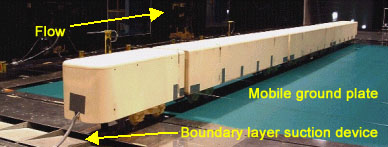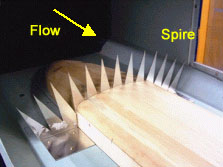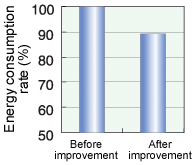| 1. Evaluation of Air Resistance Reduction for Conventional Line Vehicles | |||
|
As a result of the substantial weight reductions in conventional line vehicles, air resistance has come to represent an increased proportion of running resistance. Measures to reduce air resistance were therefore proposed and have already produced positive results. In this study, the reduction of air resistance due to improved vehicle shape was evaluated by a wind tunnel test in which the air flow around the vehicle was reproduced. Using a boundary layer suction device and a mobile ground plate, the flow under the vehicle floor was reproduced (Fig.1), and a method of reproducing the flow over the vehicle roof was proposed by mounting spires upwind of the model (Fig.2).
The following shows the air resistance reduction from improvement of the vehicle shape of a 10-car commuter electric train.  Fig.1 Wind tunnel test using a mobile ground plate and a boundary layer suction device (large low-noise wind tunnel)
|

